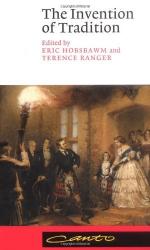
|
| Name: _________________________ | Period: ___________________ |
This test consists of 15 multiple choice questions and 5 short answer questions.
Multiple Choice Questions
1. Hobsbawm asserts that the overtly or tacitly accepted rules of traditions must have a ______ nature.
(a) Antibolic.
(b) Archetypal.
(c) Symbolic.
(d) Transitional.
2. The book asserts that traditions are invented when old ____ forms are deliberately not used or adapted.
(a) Religious.
(b) Political.
(c) Psychological.
(d) Social.
3. The Scottish symbols are ascribed to antiquity; however, they were developed much more recently as a protest against _______.
(a) France.
(b) Ireland.
(c) Germany.
(d) England.
4. According to the book, the basic type of invented tradition was called ______, which outlined the historical practices of a particular group.
(a) Communistic.
(b) Egalitarian.
(c) Libertarian.
(d) Communitarian.
5. One of the parts of Welsh history held that the Welsh were first _______ and fought against the pagan Saxons.
(a) Christians.
(b) Buddhists.
(c) Jews.
(d) Muslims.
6. The ________ is a set of musical and poetic competitions for which prizes are awarded.
(a) Arhianrod.
(b) Glendower.
(c) Eisteddfod.
(d) Morganwg.
7. Hobsbawm claims that new invented traditions tend to be _____ and not binding, and inculcate general values.
(a) Linear.
(b) Direct.
(c) Vague.
(d) Clear.
8. A number of ministers from all of the following backgrounds except ______, began to use Druidic theology.
(a) Anglican.
(b) Catholic.
(c) Dissenting.
(d) Unitarian.
9. The author suggests that the ______ established in created rituals is false and only seems real in the mind.
(a) History.
(b) Division.
(c) Ecstasy.
(d) Continuity.
10. The author discusses the history of the kilt, which is also known as the ________.
(a) Wrap.
(b) Philiabeg.
(c) Highlander.
(d) Skirt.
11. The people of the Highlands are known as a _______ society.
(a) Germanic.
(b) Celtic.
(c) Berber.
(d) Barbaric.
12. According to ______ Morgan, there were a number of groups and individuals who were involved in preservation of Welsh culture.
(a) Peter.
(b) Prys.
(c) Brys.
(d) Bryn.
13. In particular, the author suggests that historians pay attention to the creation of all of the following concepts except _______.
(a) Nation.
(b) Nation-state.
(c) National symbols.
(d) United Nations.
14. After the victory at ______ , the English made several moves to destroy the Highland way of life.
(a) Ossian.
(b) Culloden.
(c) Darnaway Forest.
(d) Skye.
15. According to the book, Welsh scholars and patriots rediscovered past traditions in all of the following areas except ______.
(a) Historical.
(b) Linguistic.
(c) Literary.
(d) Musical.
Short Answer Questions
1. The book Invention of Tradition is _______, meaning that it pulls on several different knowledge areas.
2. Hobsbawm asserts that invented traditions can often be found when cultures look to maintain ______ patterns.
3. Hobsbawm asserts that exceptions to the decline in question 22 exist in all of the following areas except ______.
4. The Welsh lineage included all of the following backgrounds with the exception of _______.
5. The author claims that the Scots were merely ______ invaders from the fifth century and the Scottish culture was a crude imitation of the invaders.
|
This section contains 417 words (approx. 2 pages at 300 words per page) |

|




